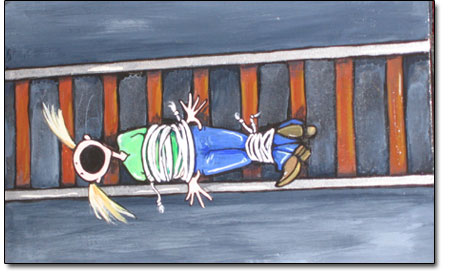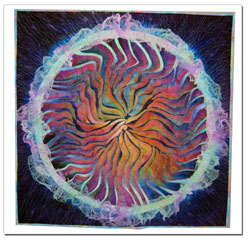| ||||
‘High Drama’ at the DAC
by Jules Masterjohn Political scandals, backroom deals, interfamilial difficulties and middle school girls having a spat all come to mind when identifying “high drama.” According to the website www.english-test.net, the term is “an expression describing an incident or series of incidents in which people get very excited, make a lot of noise and shout and get angry.” Of the 21 artists who are showing in the “High Drama” exhibit at the Durango Arts Center this month, very few took the theme literally, instead creating works that range from the personal to the metaphysical. The show was conceived to celebrate the opening season of the Diamond Circle Melodrama in its new location at the DAC. A number of local artists were invited to attend a melodrama performance, free of charge, and then take their perceptions back to the studio and create. As one of the artists invited to participate, I got an idea immediately for a three-panel collage depicting portraits of a damsel in distress, a mustached villain and a handsome hero. The storyline comes from a gag I heard many years ago, where the woman states, “I can’t pay the rent!” The villain counters, “You must pay the rent!” and the hero responds, “I’ll pay the rent!” This seemed like an appropriate image for a melodrama exhibit. Yet in my twisted mind, I imagined using a light day panty liner as the mustache on the villain, as a bow in the woman’s hair, and for the hero’s bowtie. Fortunately for all, my schedule got busy and I lost interest in my quasi-Feminist visual one-liner. Miki Harder took the melodrama one-liner, however, and elevated it to a new height with her diminutive painting, “No Hero in Sight.” Tied up on a railroad track, a blonde pigtailed and contemporarily dressed woman lies screaming. We can almost hear the shrill sound emanating from the one-inch black hole that is the only feature to be seen on the damsel’s face. The title is as important to Harder’s theme as is the image itself. Placing this melodramatic scene in present time invites a Feminist reading that, despite the possibilities of financial and legal independence, women still need to be rescued. A provocative analysis perhaps, yet it leads to a nongender specific interpretation that we humans all want to be saved from the dastardly deeds of the irreverent and powerful. A New Age perspective might be that we’ll each have to cozy up to our vulnerability and get out of this mess by using our personal power, for there is no savior outside ourselves. We, the ropes that bind, and train, are all one. A small painting that not only inspires contemplation on the nature of helplessness, it also sparks a big belly laugh! Another artist, Amy Vaclav-Felker, mined the stereotypic images associated with the theatrical genre in her folk-artsy sculpture, “Snidely Whiplash.” A paper mâché snake, he is dressed in the typical scoundrel’s garb of a black cape and top hat, standing erect with the tip of his tail stroking his mustache. Count on Vaclav-Felker to offer a lavishly dressed, humorous and anthropomorphic depiction. Tirzah Camacho, in her direct and personal style, turns the “melodrama as inspiration” assignment into a critique of the dramatic form in her painting, “Accordingly.” Camacho’s painting is large and graphic with the image of a train riding on shaky tracks. This image is superimposed over an upside down American flag, which traditionally serves as a distress call. Handwritten text follows the red and white stripes across the picture plane, revealing the artist’s feelings about her first melodrama experience. It reads, “The irony is almost too much to stomach: brown-skinned girl sits in an ocean of blue-haired tourists … The plot: white men cheating other white
men, fighting over gold and women, the crowd cheering and booing accordingly. At intermission, everyone sings along to the familiar ‘This Land is Your Land’ except me.” It’s not surprising that she created a piece with this sentiment, given that she “often confronts imperialism and the exploitation of land and people in her work.” As an appreciator of theater and a supporter of the DAC, Camacho is able to separate the “fantastic” talent brought to the stage from the content of the genre, which she says is “… dated, remedial and stemmed from my old friend MANIFEST DESTINY!” From her Native American perspective, stereotypes and romantic images don’t lead us to a better world, which is the role of art in Camacho’s. Taking us into the world of the occult, Judy Hayes has created a tarot reading for the Diamond Circle Melodrama. In her colorful and visually active mixed-media collage, “Fortune Telling is Risky Business,” Hayes’ prediction pictures the Queen of Swords and the Page of Pentacles as well as The Chariot and numerous Cups cards. With varying symbolic meaning associated with each card, deciphering Hayes’ message is perplexing. There is a disquieting feeling in the work and the title supports this sense of foreboding. Alison Goss takes us even further to the outer edge of common experience with “Opening Night,” a mandala of hand-dyed fabrics machine stitched together. The abstract image is powerful, as if Goss is portraying the fertilization of an egg or the sun in a particularly active solar phase. She has the ability, with fabric, paint and thread, to conjure up the energetic foundation that the micro-and macrocosmic worlds share. Like a shutter on a camera lens, Goss’ gossamer fabric is poised to open, releasing the excitement of the Melodrama’s opening night. Drama on a cosmic scale is embodied in Goss’ orb of expansive power. Here we see drama of the Highest Order. “High Drama” is on display through Aug. 29 at the Durango Arts Center, located at 802 E. Second Ave. Gallery hours are 10 a.m.-5 p.m. Tuesdays –Saturdays. •
|



